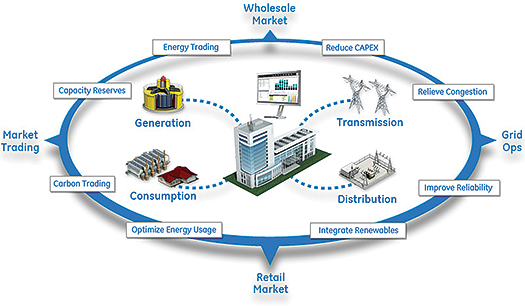By recent estimates, the energy industry is expected to spend more than $51.1 billion improving the U.S. electric infrastructure by 2023.1 Commentary from industry experts suggests this staggering amount can be explained by the state of our aging infrastructure and general macroeconomic trends. This realization, however, will undoubtedly cause policymakers and regulatory agencies to ask the question: Are we making the smart investments needed to meet tomorrow’s energy challenges?
Considering this question, an area that deserves attention is the integration of Demand-Side Management (DSM) strategies with the safe and reliable delivery of electricity. Utilities that dynamically understand and incorporate demand response into their planning and operations cycles will reach a level of efficiency in distribution and economic spend consistent with the smart grid vision. This accomplishment will marry the somewhat disparate worlds of Demand Response Management Systems (DRMS) and Advanced Distribution Management Systems (ADMS), as technology alignment will be a prerequisite to the alignment of overall business objectives.
Many of today’s DMS strategies have been designed to address temporary supply-side gaps or improve reliability margins. For example, direct or interruptible load control programs are used to shed or shift load during 100+ hours of peak demand that occur during the winter or summer months. In other cases, time-of-use (TOU) and peak pricing programs charge higher rates to curb energy usage and accommodate the higher cost of peak generation. A more effective demand optimization or DSM strategy will account for the implications of reduced demand across the value chain, from supply and delivery to individual energy consumption. Consumer awareness of both energy efficiency and the increased costs of energy usage will continue to grow. As this happens, the landscape for how our transmission and distribution assets are planned and managed will change along with the technology required for delivery.
Demand Optimization across the Value Chain

This transformation in the industry has already begun as current practices are blending into an integrated approach that will combine previously separate responsibilities into a single business objective. For example, the vast amounts of meter data available can be summarized by performance analytics that provide insight into regional and segmented load growth trends. These analytics on consumer energy usage can therefore be a path to informing long-term capital investment needs or infrastructure needs. However, DRMS solutions also contain the critical aspects of a control system, in that many will incorporate the ability for fast load shedding or sending dynamic price events real-time. An effective DRMS will be designed around the integration of existing systems, then layer several advanced capabilities upon that platform before grid operations value can be demonstrated with an ADMS. The following are some of those key capabilities required:
- Network Awareness: Being able to synchronize the type and location of assets on the normal state of the electrical network is a critical first step. Only by controlling load at various states around the grid can a true operational capability beyond traditional bulk load shed be provided.
- Customer Awareness: Incorporating the various program and contractual arrangements of residential, commercial and industrial consumers will need to be centralized before decisions can be made. While an operations department will not require the details on an individual consumer basis, they need the assurance that a system is only releasing the load that can be appropriately reduced at the desired times.
- Forecasting: Calculations of consumer baseline and reduction forecasts from meter level data should also include consumer participation rates and various other policy factors. Not only does this method facilitate market and consumer settlements, but also statistics show behavior-based analytics are a stronger indicator of expected future performance than specific device calculations.
- Visualization: Providing grid operators with a view that provides contextual awareness of the available load resources and reduction scenarios needs to be presented and based on the information feeding in from several discrete sources.
By enabling each of these capabilities within a single DRMS platform, demand response will be positioned to provide value beyond what previous DSM strategies could anticipate. For example, the GE-designed PowerOn™ Precision DRMS uses these capabilities in a single demand response platform as part of an Asset Control suite of grid management solutions. This strategy naturally integrates the DRMS capabilities as part of an overall solution towards improving grid performance and increasing the reliability and efficiency of grid operations.
The benefits enabled by this type of integrated solution, including an ADMS built to use DSM strategies, can be used to build a very attractive business case. While many of these benefits may differ based on the user’s organizational structure, they can be divided into two approaches that impact either investment or operational strategies.
Reduce CAPEX: Reducing or limiting the load growth on various substation and power delivery assets can delay the cost of building additional generation and transmission assets. With careful planning, capital infrastructure investments could be adjusted to accommodate DSM strategies and align more closely with tightened budgets.
IVVC Control: While Volt/VAR control is often treated as a demand-side management strategy, accounting for these actions in coordination with consumer-controlled demand response strategies would provide new options to grid operators.
Improved Reliability: Evaluating demand response as load shed options in lieu of bulk load shed would improve options for maintaining reliability. The ADMS could take load reduction measurements by location in real-time to adjust the current load flow calculations.
Educating and engaging consumers about the societal benefits that can be achieved through their participation in DSM strategies can have a significant effect on our investment in asset management and control strategies for the smart grid. According to the FERC Assessment of Demand Response & Smart Metering report published last December, the potential demand response contribution has grown by 18 percent over the past two years and now represents 9.2 percent of U.S. peak demand.2 By advancing the integration and use of DRMS capabilities through an ADMS strategy, grid operations will be in a better position to manage the transformation of energy delivery due to dynamic consumer demand.
About the author
 Jamison (Jay) Shaver is the senior product manager for Digital Energy’s Demand Optimization product line. Since 2009, he has led the business strategy and technology development of GE’s demand response offering. Jay joined GE in 2008 through the Junior Officer Leadership Program where he successfully managed global projects across several platforms and technologies. He holds a Bachelor’s degree from the U.S. Naval Academy in Annapolis, Maryland and received an MBA from Emory University.
Jamison (Jay) Shaver is the senior product manager for Digital Energy’s Demand Optimization product line. Since 2009, he has led the business strategy and technology development of GE’s demand response offering. Jay joined GE in 2008 through the Junior Officer Leadership Program where he successfully managed global projects across several platforms and technologies. He holds a Bachelor’s degree from the U.S. Naval Academy in Annapolis, Maryland and received an MBA from Emory University.
1 Edison Electric Institute, “Transmission Projects at a Glance” (March 2013)
2 FERC Assessment of Demand Response & Smart Metering Staff Report (December 2012)






